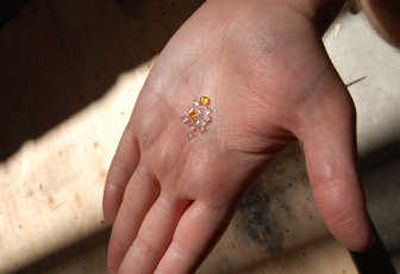Discs are ready to fly

The first Blu-ray discs could come off the line at a new downtown Spokane plant in two or three weeks, BlueRay Technologies Inc. executives said Tuesday.
Several large machines, which will print and label high-definition Blu-ray discs, occupy part of a basement clean room under construction by the Valencia, Calif.-based company at the Commercial Building, 1119 W. First Ave. The equipment will be capable of churning out as many as 14,000 of the next-generation video discs a day, said James Schumacher, vice president of operations.
It likely will take another couple of weeks to tune the machines for commercial production, said Erick Hansen, CEO and chief technologist.
Locked in a “format war” with HD DVDs, single-layer Blu-ray discs hold 25 gigabytes of data, such as movies or PlayStation 3 video games — five times more than fits on a standard DVD. Sony-backed Blu-ray has received key support this summer, with Blockbuster announcing in June it would carry mostly Blu-ray discs and retailer Target Corp., the nation’s second-largest retailer, announcing last week it would carry exclusively Sony Blu-ray disc players in stores through the holiday season.
BlueRay Technologies last month signed a production contract worth an expected $2 million to $4 million, according to the company.
“French film producer Joe Levy and director Eric Atlan have contracted us to begin replicating their film library on Blu-ray disc,” according to a company Web site. “The initial order is for 300,000 units per title, expanding to several million over the next year. … This is the first closed deal of a dozen we are currently negotiating.”
Company officials declined to comment further on other contracts.
Once other disc lines are installed, the plant could do about 80,000 discs a day, Schumacher said.
But the company doesn’t have enough power to run several more machines needed to make CDs, DVDs and other discs, Hansen said. The company has shut off power to the top two floors of the three-story historic building. The situation is causing weeks of delay and budget problems for BlueRay, which has already gone over-budget in some areas, Hansen said.
Initial plans called for the plant to open in June, after BlueRay bought the building out of foreclosure.
“We’re close, but it could be better,” Hansen said.
Avista Utilities has worked with BlueRay since earlier this year, but the utility never received an exact figure for how much power BlueRay would need, said spokesman Hugh Imhof. Avista is working on temporary set ups, but providing permanent service that roughly doubles the building’s existing power will require upgrading Avista’s infrastructure downtown, he said.
“It just seriously needs to be bulked up,” Imhof said. “It’s something that just takes time.”
After the building’s sale, BlueRay told a nonprofit mental health agency and more than 40 residents living in federally subsidized, single-room apartments to vacate. All the residents have relocated, and the company took its time letting them move out, Hansen said.
“We did everything in the world to be a good citizen,” he said. “I think we’ve been pretty successful in it.”
Hansen said three engineers from General Electric research and development will fly in to help set up the factory and train workers.
BlueRay will look to hire about 20 to 70 local people to run the plant 24/7, Hansen said. Most salaries could start at $10 an hour, he said.
The clean room will house eight machines, said Schumacher, who worked for Hansen at his Optical Disc Media DVD plant in Valencia. The first equipment to be installed will produce single-layer Blu-ray discs. Later phases will add machines for dual-layer Blu-ray discs, mastering and packaging, he said.
The room, painted white with blue trim, will be pressurized and air conditioned, and the individual machines have their own air filtering systems, Schumacher said. It features several two-way mirrors to give school tours a way to watch Blu-ray production without disturbing workers. An opening in the ceiling will be housed in a metal and glass structure affording downward views from the ground floor, which contains a reception area and offices.
BlueRay will stamp information onto discs, not “burn” it with lasers like rewritable DVDs used at home.
To make a Blu-ray disc, heated polycarbonate beads move from a dryer and into a hopper, which can store about 5,000 pounds of plastic, Schumacher said. The plastic then feeds into a European-made “injection molding machine,” which heats it to about 680 degrees Fahrenheit and shoots it into mold cavities, which clamp shut with about 40 tons of force, stamping data onto discs in the process, Schumacher said. Each disc takes about 4.5 seconds.
A handling arm moves the resulting transparent, 1.2 millimeter-thick discs to a larger adjacent machine. Part of the machine coats the disc in metal by combining a jolt of electricity with argon gas, creating an explosion that scatters molecules evenly across the disc, Schumacher said. One side receives a silver reflective layer, and the other side gets silicon to protect it.
Next, what Schumacher called the “top-secret part of the formula for Blu-ray” coats the disc with a cover layer that is dried by ultraviolet light. Discs then get a scratch-resistant lacquer coating and are checked for quality.